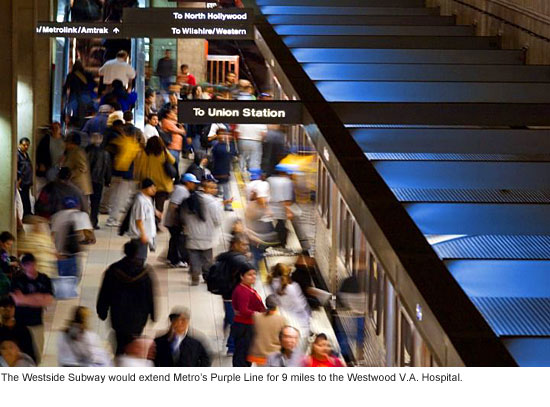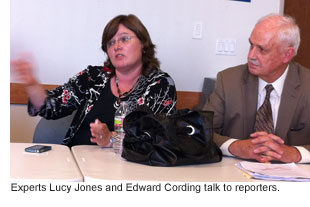Experts onboard with Westside Subway
October 19, 2011
 A key stretch of the Westside Subway could safely be built under the Beverly Hills High School campus, a high-profile panel of experts told a Metro committee Wednesday after reviewing the results of extensive testing for earthquake hazards, vibration and noise, subterranean methane gas and abandoned oil wells.
A key stretch of the Westside Subway could safely be built under the Beverly Hills High School campus, a high-profile panel of experts told a Metro committee Wednesday after reviewing the results of extensive testing for earthquake hazards, vibration and noise, subterranean methane gas and abandoned oil wells.
On all counts, the experts said, subway tunneling under the school could be accomplished without endangering students or others, without undermining the school’s role as an emergency evacuation center and without interfering with plans to one day remodel the campus to include an underground parking garage or other buildings.
Significantly, the experts also concluded that it would be dangerous to build the Century City subway station on Santa Monica Boulevard, one of two locations under consideration, because of the presence of two active earthquake faults, one running parallel to Santa Monica Boulevard. The other potential Century City station site—at Constellation Boulevard and Avenue of the Stars—is not on an active fault and thus remains a viable option for a station, the experts said.
The experts’ testimony before the Metro board’s Planning and Programming Committee could play a pivotal role in the subway’s planning. While the committee members took no positions Wednesday on what they heard during the briefing, the question of where to place the Century City station has been a matter of heated debate, with many in Beverly Hills vigorously opposing the Constellation station because the route to get there would pass under their city’s high school campus.
Those testifying included not just experts from project’s tunneling advisory panel but also members of a specially-convened group of prominent independent reviewers brought in to assess the soundness of the research.
One of the independent experts, seismologist Lucy Jones of the U.S. Geological Survey and Caltech, said her group “completely agreed with” the conclusion that “the Santa Monica Boulevard station sites would be dangerous to build on.”
At the same time, she emphasized that it is possible to safely to build tunnels through earthquake zones by having the tunnels cross the faults at a sharply perpendicular angle. That would be the case in the route involving the Constellation station.
“To build a subway in Los Angeles, you can’t avoid earthquakes,” Jones said. “They’re going to be here. And you cannot avoid faults. You can, however, build effectively around faults and it’s been done in a lot of locations: in Los Angeles, in San Francisco, Mexico City…What you’ve got to try to do is to put your tunnels at a high angle, close to perpendicular to the faults, and avoid ever putting a station in a fault.”
Also testifying was consulting earthquake geologist James Dolan, a professor of earth sciences at USC who is among the project’s fault experts. (For a full list of the experts, click here; their full reports are now posted here, along with a letter on their findings.)
Supervisor Zev Yaroslavsky, a member of the Metro committee, said bringing in an independent expert peer review panel made up of “people that the public knows and recognizes” was important and, “given the rhetoric that’s been freely flowing out of Beverly Hills,” could help alleviate concerns about the impartiality of the scientific research.
And he stressed the significance of what’s at stake.
“This has to be a decision, when we make it, that has to be based on science and facts, not based on what we feel or think based on our gut,” Yaroslavsky said. “This is a very expensive decision that we’re going to make. It’s a profound decision both in terms of planning and in terms of finances. If we build a station in the wrong place and three months after we build the station we have an earthquake and the station is destroyed and people are killed, we have an issue.”
Beverly Hills Mayor Barry Brucker attended the committee meeting and said afterward that he found the presentation impressive. Still, he said it is important to have the city’s own experts review the scientific reports, particularly when it comes to the finding of no active faults at the Constellation Boulevard site.
“I’m not skeptical of the science but we are going to have our consultants get all that data,” Brucker said. “It’s just good prudent governance to have a second independent peer review that we commission.”
In a statement, Beverly Hills Unified School District president Lisa Korbatov said Metro had opened a “veritable Pandora’s box” with the seismic data presentation, and said the agency had held on to the data for too long without sharing it with the public.
Metro CEO Art Leahy responded with his own statement Thursday morning, saying that key information was made public soon after it was first analyzed. “Within just the past few months,” Leahy said, “our technical experts have located precisely long-suspected fault features. Their work was reviewed and confirmed yesterday by independent reviewers I engaged six weeks ago.”
Supervisor Michael D. Antonovich, also a member of the Metro committee, asked during the meeting how much the experts were being paid. Metro officials said they were unable to immediately provide the figure but said it was part of the project’s overall budget. After the meeting, Jones said that, as a U.S. government employee, she was not being compensated for her work but was doing it as part of her job.
The Metro board last year approved the subway project’s draft environmental impact statement/report, with a proposed route that included the two possible locations for the subway’s Century City station.
At the same time, the board approved a motion by Yaroslavsky calling for a thorough review of all the potential risks around the high school and throughout West Beverly Hills, Century City and Westwood.
Wednesday’s oral report to the board committee represents the first public accounting of what the experts found. Their assessment will be included in the project’s final environmental impact statement/report, expected to be released this winter.
After a final round of public comments, Metro’s board is expected to vote on the project early next year. As currently envisioned, the Westside Subway would be a 9-mile extension of Metro’s Purple Line, with seven new stations ending at the Westwood V.A. Hospital.
Some construction could begin as early as 2013. If completed by 2022, the project could cost an estimated $5.3 billion. Funding will come in part from Measure R, the ½-cent sales tax approved by county voters in 2008, but federal money will also be required.
Here, based on testimony and executive summaries posted Wednesday, are some of the experts’ conclusions:
There is “no reasonable tunnel alignment” that could avoid passing under any structures on the Beverly Hills High School campus. (A presentation during the meeting showed that the tunnel would only run under Building B of the high school’s south wing, not the gym/pool building.) The depth of the tunnel—55 to 70 feet below the surface—would allow space for a future structure such as an underground parking lot to be built above it, the summary said.
Vibration from subway trains traveling under the campus would be 64 decibels or less—below the federal threshold of 72 to 75 decibels. The noise level would be no greater than 33 decibels, less than the federal standard of 35-40 decibels.
Advances in tunneling—notably through the use of pressurized closed-face tunnel boring machines—will minimize the risk of ground settlement during the project and were successfully used in building the Metro Gold Line’s Eastside Extension, the summary said.
Tunnels would be built to “maximum design earthquake” standards using the closed-face tunnel boring machines and special water-tight and gas-tight liners. “Since the tunnels will be designed to not collapse during an earthquake, the tunnels will affect neither the threat to buildings above active faults during an earthquake nor the severity of the shaking,” the executive summary said. Thus, there would be no effect on the high school’s role as an emergency evacuation center.
As for abandoned oil wells on the campus, magnetic testing found “one anomaly” on the west edge of the school’s lacrosse field that may or may not be the metal casing from an abandoned well. Hi-tech advance testing would enable construction to safely work around the obstruction if it turns out to be an inactive well, the report said. It also noted that an abandoned oil well that appears on maps of the area is located under a parking structure on Century Park East, not under the high school.
Almost the entire project is located within the city of Los Angeles’ “methane zone,” and testing for methane and hydrogen sulfide gas around Constellation Boulevard found concentrations that “could be explosive under unfavorable conditions.”
However, advances in machinery, technology and regulation—and decades of tunneling industry experience—have made it possible to tunnel safely through gassy ground. The report also noted that higher levels had been found, and successfully overcome, during construction of the Red Line in downtown Los Angeles.
Overall, the summary said, “The project is not expected to pose new threats to the students, faculty or community as a result of its construction and operation.”
Posted 10/19/11












 405 bridge work causes a stink
405 bridge work causes a stink

